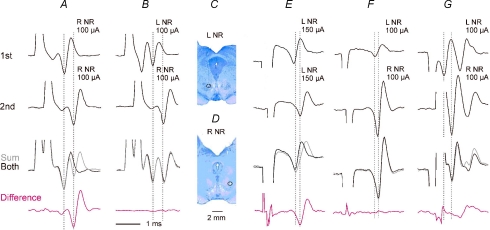Figure 3. Interactions between descending volleys evoked by stimulation of the red nuclei on both sides.
Averaged (n = 10) descending volleys recorded from the cord dorsum at the level of the C3/4 segments following stimulation of the left (L) and the right (R) red nucleus (NR). A, effects of two stimuli 0.4 ms apart, applied through the same electrode, separately (1st, 2nd), or jointly (both, black trace), the sum of potentials evoked by the 1st and 2nd stimulus (grey trace) and the difference between the sum of the volleys evoked by the separate stimuli and the volleys evoked by their joint application. Dotted lines indicate the onset of indirect components of the volleys, which were in this case larger than the direct. Note that the difference and the volley evoked by the 2nd stimulus alone were practically identical, showing that when this stimulus followed the 1st stimulus it did not add to its effects because all the fibres activated by the 1st stimulus were during refractory period. B, as in A but when the two stimuli were applied on the left and right side, respectively. Note that the direct volley evoked by stimuli applied within the left NR was larger than that evoked from the right NR but the time intervals between indirect volleys evoked from the two nuclei were the same as in A. In this case there were no indications that the same fibres were excited by the two stimuli, or at least that the number of such fibres was very small, because there was hardly any difference between the sum of separate effects of these stimuli and the effects of their joint application. C and D, marking lesions indicating location of the stimulating electrodes in the left and right NR from which the volleys in A and B were evoked. When the collision test was repeated for stimuli applied at different depths on the left side, the first stimulus was found to activate fibres that were refractory at the time of application of the 2nd stimulus only when it was applied 1 mm deeper. E and F, as in A and B but from another preparation in which only indirect volleys were evoked from either the left or the right NR. G, as in B but in a preparation in which both direct and indirect volleys were evoked from the left and right NR. The stimuli were timed such that the direct volley from the right NR was delayed with respect to the direct volley from the left NR; dotted lines indicate the onset of these direct volleys. Note that during the period corresponding to the second direct volley, the sum of the records (grey) was not larger than the volley (black) induced by joint stimulation of the two nuclei even if there were differences in the indirect components which might reflect activation of neurones that were not activated directly. The records are with the negativity up. Shock artefacts have been truncated.

